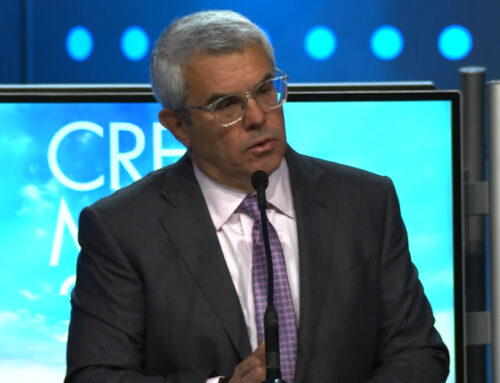With all this talk about being “late in the cycle”; are you protecting your downside? IF you are protecting your downside, are you also taking measured growth bets in some structured relative sized manner?
It’s competitive out there for business. We all are experiencing it. Are we falling to the temptation to reach for a deal? Are we competing by taking more risk (and not getting properly paid for it) when we should be doing just the opposite – protecting our downside? OR, are we competing on price?
On the flip side, is this the time in the cycle to chase yield? Are we trying to get money out now because of a fear that credit opportunities will dry up and there simply will not be enough opportunities to lend on in the future?
I remain bullish. I still think it’s a great time to be in the CRE space. We are experiencing an unprecedented river of capital flow – that’s what’s driving the competition for business. It is also true that this unprecedented level of liquidity drives opportunity AND makes innovation worthwhile to consider.
I am excited about the opportunity for innovation in our space. For this blog, let us leave out of the discussion technology. I think there are product and service innovations happening all around us. It makes me wonder what more each of us can be doing in our businesses to make the experience for our clients better, faster, more efficient and effective? Can we add products and services, at the margins of our offerings, that somehow fuel further growth, revenue, profits, and expansion?
There seems to be examples of additional revenue model enhancements all around us – the applications that relate to a hospitality context applied to multi-family product is just one example. I hear WeWork, in a few locations, is testing out first floor “coffee shop” spaces to use as a portal into their “above second floor space”, where you can get “Business Center Services” as well as rent a desk or an office or a conference room by the minute. What a clever idea! As brick and mortar products innovate and evolve so too must capital products.
IF the millennials and their love for a sharing economy are what is driving, in part, the shared office space concept, my bet is that lease terms will shorten from the traditional 10, 7, and 5-year durations, all across the industry. IF that is the case, how will that alter the rating agency cash flow modeling that drives CMBS execution? Will the real estate lending business go back to “what is my basis on a loan per square foot?” – type underwriting?
Innovation is what created the CMBS world. A collection of industry vets (today), 25 years ago, applied bond ‘technology’, and used the existence of the RTC, to securitize the income streams created by the pooling of commercial mortgages. Decades later, CLOs and CDOs were applied to CRE Lending as well. As everyone continues to whine about the “typical borrower experience” in the CMBS world, some are finally innovating action. PSAs are being rewritten to change the relationship between DCH, Special Servicers and Master Servicers specifically to enhance the borrower experience in terms of turnaround times, decision making, and proactive interactive attention to addressing CRE issues that surface during the life of a loan.
What else?
My conclusion is that most will pick their spots, stick to what they know, and protect their downside.
Observations, worries, soundbites:
- Cash flowing assets are being priced to perfection, in terms of price and credit. More and more folks, in search of yield, are taking on construction lending and deep value-add bridge loans. In this “lower for longer” reality, innovation (even a subtle twist on a mature play) may offer a better risk adjusted return.
- There is reported to be hundreds of billions of dollars categorized as “dry powder” sitting on the sidelines. Capital sitting on the sidelines, desirous of getting into the game, is a likely driver of and benefits well from product innovation. Does this excess capital finally affect values in our asset class?
- Dry powder absolutely represents cushion to the inevitable downturn; and, combined with relatively (to 2007) lower levered balance sheets of our institutional users and providers of capital, tells me that the downturn will be short and relatively harmless. (That said, my mom use to define ‘minor surgery’ as surgery on someone else!)
- Being reactive, tactical and transactional may cause a leader to become a follower and simply cause many to fall behind those who are strategic, proactive and innovative in their transactional execution.
- I always feared the professional (or individual for that matter) who defines right and wrong by what they can get away with (rather than by a standard of excellence that they aspire to). The market opportunities feel to me that more than a few intermediaries, as well as some rare borrowers, are pushing for that last bite of the apple in a deal. Figuring they won’t get what they don’t ask for, I wonder if they would consider “age old honor among thieves”? Not that anyone cares who gets “their hand caught in the cookie jar”; is it a sign that the borrowers and brokers see the cycle as being very late; and, as such see the end in sight? “Last call” anyone?
- Remember back in 2006/2007 how many conduits were new and fighting their way into the marketplace? Almost 15 years later, it seems to me that CLO ‘innovation’ is creating a similar set up for all the new debt funds. It has been said, ‘history doesn’t repeat itself; however, it sure does rhyme!’
- Libor replacement is a BIG deal.
- I read recently where the US needs to create 100,000 jobs a month to keep up with population growth. TALENT MATTERS. The fight to hire, train, keep, steal, talent is fierce. It only will get more competitive. What is your proactive strategy for your firm to grow with the best educated and trained talent?
Enjoy your summer.
Latest posts by Jack Cohen (see all)
- JackChat July 2024 - July 3, 2024
- JackChat March 2023 - April 1, 2023
- JackChat December 2022 - December 18, 2022





